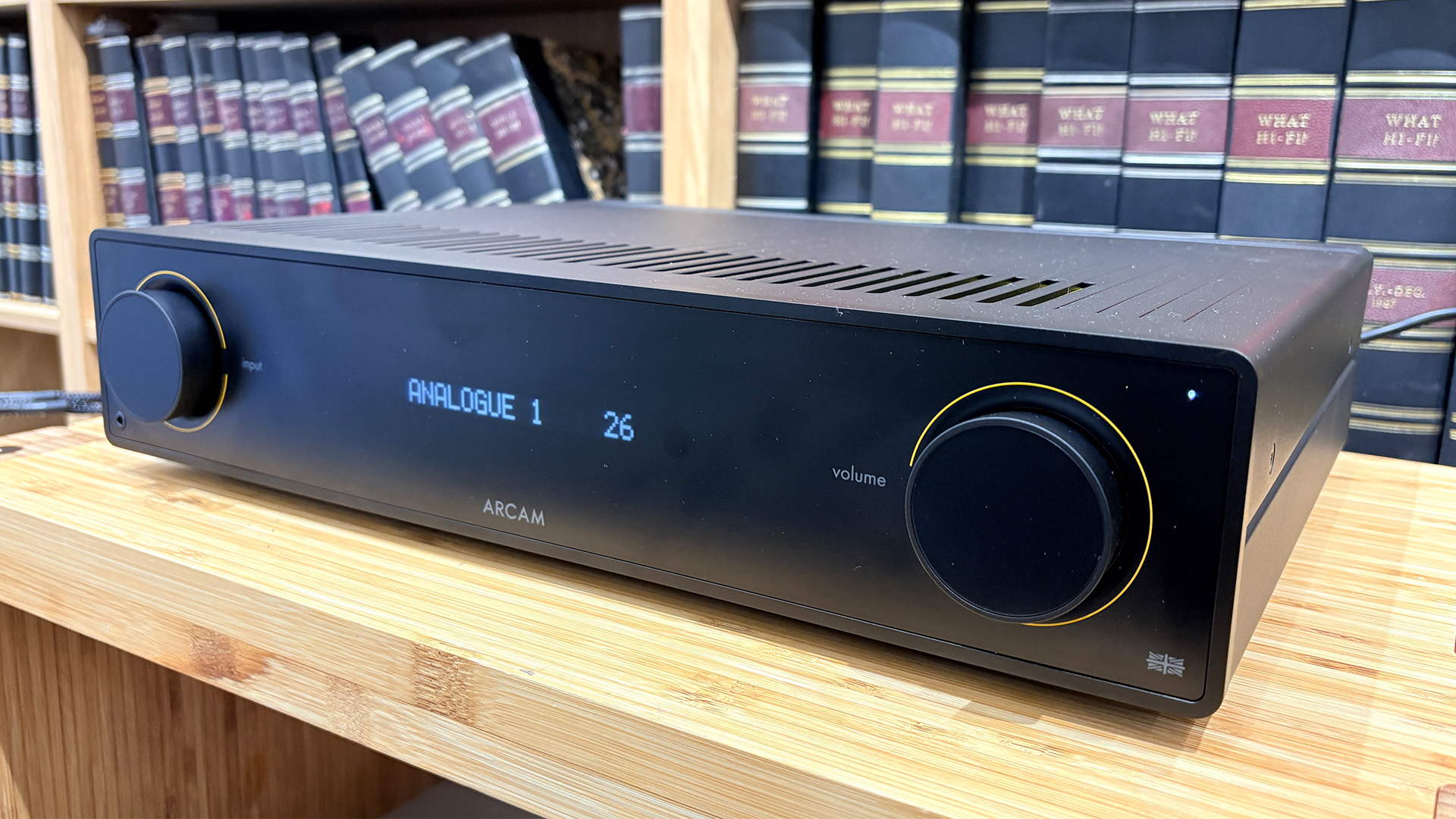Pro-ject: still re-inventing 20 years on
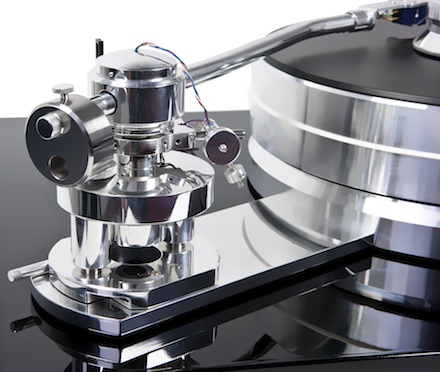
I’ve been in Vienna, attending the 20th anniversary of Pro-ject, the company often cited as being almost single-handedly responsible for the vinyl revival.
But while founder and president Heinz Lichtenegger gave us a look back at the way the company started, and we were invited to visit the hi-fi shop (above) he was running at the time he had his big idea two decades ago, this has been anything but a wallow in nostalgia.
For just as Pro-ject built its business by seizing an opportunity at the time – huge amounts of almost free music available on LP as the world switched over to CD –, so it’s embracing the new world of music stored on computers and portable devices with a whole range of new products.
This year, for the first time, it sold more of its Box Design line-up of dinky electronic components than it did turntables, and Lichtenegger has an almost missionary zeal to spread the word of good sound among those more used to music on iPod than LP.
Don't give up on the iPod generation
Unlike some in the hi-fi industry, which has more or less given up the ‘iPod generation’ as a lost cause, Pro-ject – and specifically Lichtenegger – has been out on the road showing retailers how they can attract just these buyers into the purchase of systems to make the most of their music.
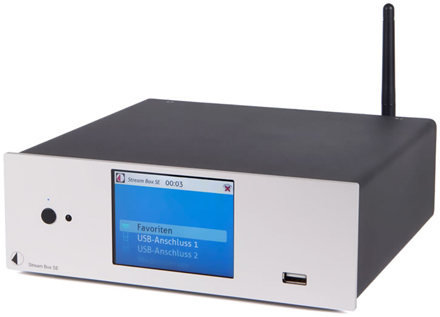
That thinking is behind units such as the company’s €700 StreamBox SE (above), its debut product in the network/internet streaming market, and the MediaBox player (below) for music stored on USB and SD devices.
The latest hi-fi, home cinema and tech news, reviews, buying advice and deals, direct to your inbox.
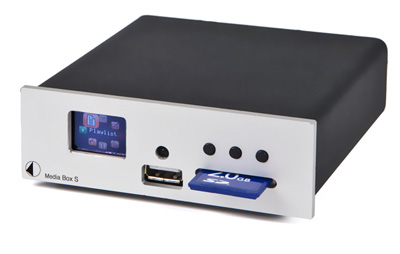
Rather than seeing developments such as Apple’s AirPlay as a threat to its business, Pro-ject is embracing such technology – not by building its own AirPlay-equipped units, but by making products such as DACs and compact amplifiers, designed to slot in downstream of the Airport Express or Apple TV and offer better sound quality from those products.
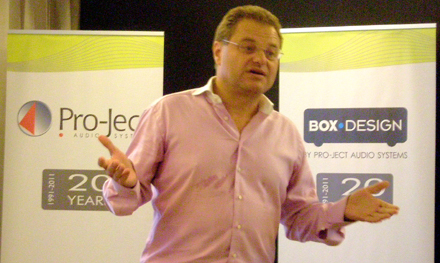
But let’s rewind for a moment to 1991, or maybe even a while before, when Lichtenegger (above) was a teenager, growing up in the Austrian countryside, and trying to decide whether to do what all his friends were doing, and buy a motorbike, or spend the money on a hi-fi system.
'Are you crazy?' moments
Of course, he went for the hi-fi system, and experienced the first of several ‘Are you crazy?’ moments: his friends thought he was mad as they raced off in search of – well, let’s be frank – girls, and Heinz stayed home buying secondhand hi-fi components, trying to get a high-end sound for not much money.
In the end, he says, it paid off – as he puts it, ‘My friends had the girls, but they were on the back of their bikes; I was already at home with a girl and the music!’
The turntable found in the rubbish
And it was another girl who accidentally started the whole Pro-ject line of turntables, Lichtenegger admitting that the original model was a throwaway product. Literally so: it was being used at a party by a Czech girl who’d come to Austria, and when Heinz asked her where she’d got it, she admitted that it’d come out of the rubbish-pile at the factory back home where her uncle worked.
Intrigued, he did some tweaking to the turntable, and in March 1991 it was submitted for review to a German magazine, where it promptly beat all-comers up to DM1000, despite being the cheapest in the test.
Here comes another ‘Are you crazy?’ moment: Lichtenegger went back to the factory to get some more, and along with questioning his sanity, the owners explained that they were in the process of closing down turntable production, which had been carried out there for decades, because no-one was buying record players any more.
Some negotiating led to production being continued, and indeed the Tesla factory at Litovel is still overseen by its production manager at that time, Jiri Kroutil, who has been with the Pro-ject project from the start.
The high-end sound for as little as possible
The idea remains unchanged two decades on: simple, low-cost, easy to use turntables, designed to bring to people what Lichtenegger calls ‘the art of listening to music’ at the lowest cost. Indeed, he’ll go further: the aim of the company has always been what he was trying to achieve when he was a teenager: the high-end sound for as little money as possible.
That’s why, he explains, the company’s Debut turntable is one of very few high-end hi-fi products you’ll find in mass retailers such as MediaMarkt in Germany, Fnac in France, and even Wal-mart in the States: it’s all about getting that quality to as many customers as possible.
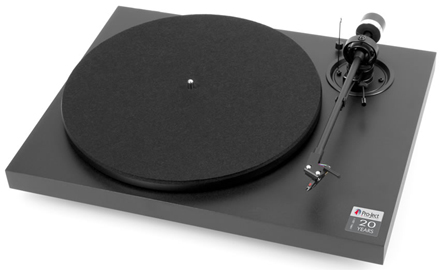
You can see that in the celebratory Pro-ject 1 Anniversary turntable (above), launched to mark the 20 years of the company: 'It's the same as the first one we ever made, with just a few changes to make it sound better and, taking into account inflation, it sells for the same price as our original model.'
Everything made from scratch
And the products are still built as they always have been: everything to do with the turntables is made from scratch in the factory in Litovel – from arms and plinths right down to the feet on which the turntable sits – and every single turntable is run for four hours and tested before being packed and shipped.
‘Yes,’ says Lichtenegger, ‘even our €199 turntable. No-one else does this – everyone else takes one or two products per hundred and batch-tests them. We run-in all our products, and test every one.’
Even the company’s growing electronic range is built in Europe, at the another factory in the Czech Republic, and for the same reasons: ‘we didn’t go to China, as so many companies have; we had the luck to work from the start with a very professional company.’
And as I later discover, the company in question only works for Box Design: this isn't some operation making products for one brand one day, and another the next.
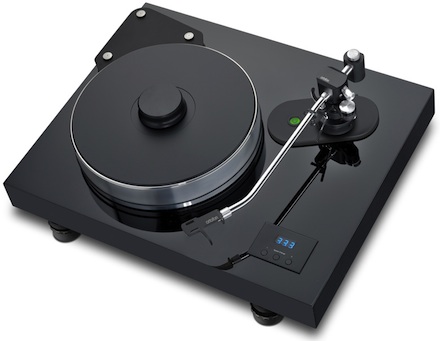
Talking about turntable development, Lichtenegger has no qualms about admitting that when it comes to turntables, he's inspired by – oh, OK then, copies –classic designs: he’s a fanatical turntable collector, and when he couldn’t find a decent used Micro Seiki from Japan at a sensible price, he built his own – the Pro-ject X-tension (above). ‘But we change and improve the design, use new materials and lower the cost.’
So how, then, does the company’s new Signature turntable (below), at €9500, fit into this way of thinking? ‘Well, this is not our typical product; this is our first baroque product. It’s state of the art, cost no object.
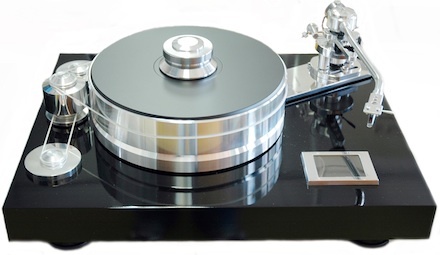
‘So why did we do it? Well, to show that if we want to do this kind of product, we can – and of course to introduce technologies we can strip down later to lower-priced models.
These days Pro-ject employs some 300 people, including 52 in its electronics division, and sells turntables worldwide, to around 80 countries. And it sells lots of turntables – around 40,000 a year - and lots of electronics.
A quarter of a million phono stages
Its first electronics product, the Phono Box phono stage - which it launched in 1998 in response to many amplifiers from Japan appearing without built-in phono capability – has so far sold over 250,000 units.
And for all that success, there’s still very much a family feel about the company, both here in Vienna and at the production base in Litovel, which I visited a few years back.
For these celebrations the company has gathered staff, distributors, retailers, friends, family and even the odd journalist, and when the export sales director mentions that he and the company’s finance suprema are brother and sister, it comes as no surprise.
In the evening after the press conference, when we hit the underground to go to Vienna’s Konzerthaus for a private concert in the Schubertsaal, the atmosphere is somewhere between family party and business event.
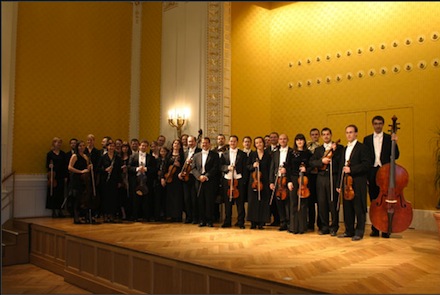
The concert, given by the Vienna Classical Players (above) and including music by Haydn, Mozart and (of course) Schubert, was excellent, and enjoyed by everyone – from the businessmen furtively prodding at iPhones and BlackBerries when no-one seemed to be looking to some of the younger members of the audience who sat enraptured at what may well have been their first experience of music of this calibre played in this highly impressive venue. I‘m with them on that one.
Anyway, that was the celebration of the past and the present; what of the future for Pro-ject and its fast-growing Box Design sub-brand?
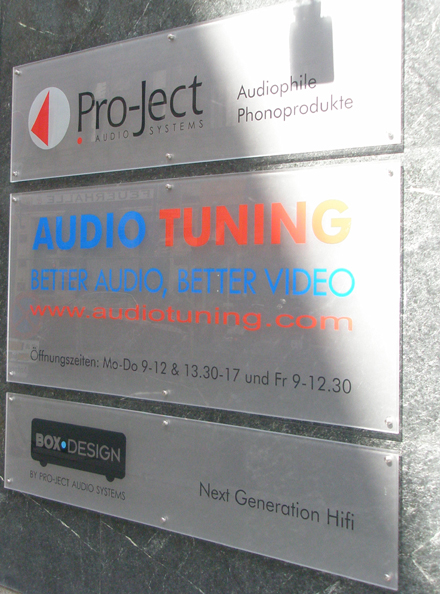
Well Lichtenegger doesn’t just head up those companies, but also runs Audio Tuning, which is Austria’s biggest hi-fi distributor – and that gives him a pretty good handle on the industry as a whole.
Which is why he’s been leading a seminar tour, training 400 people at dealer level on how to make the most of the changing face of music in the home, and avoid the mistakes of the past.
His view is that every time there’s a major innovation in the industry, the market manages to mess it up, and thus consumers lose interest.
For example, he says, when the big Japanese companies first started making serious hi-fi separates in the late 70s and 80s, the industry cashed in that with ‘1000W’ stack systems, designed to look like separates: ‘They were rubbish, and so interest declined’.
The same happened when CD was taking off – everything was labelled digital, and made cheaper and nastier year on year, and so that advantage was lost – and Lichtenegger sees the same pattern in home cinema.
Dealers and manufacturers have seen the success of companies such as Bose with small-speaker surround systems, and have rapidly tried to make the same thing at lower and lower prices, so that now we have the €200 all-in-one home cinema in a box, ‘and we’re back in the world of the budget plastic system.’
Cheap systems make people lose interest
‘And people hear how bad these really cheap systems are, and they lose interest in home cinema.'
Who, he asks, are the big loudspeaker manufacturers now? ‘Panasonic, Sony, Logitech – plastic 5.1-channel systems for €200.
'But if you look at the sales figures, they’re disastrous. Why? Because the industry gives the consumer bad products.’
And he quotes numbers suggesting that, while 90% of households have at least one MP3-type player, and 200% of households have a TV - so at least two TVs per home –, only 10% have a decent hi-fi system.
His view? Retailers need to start supplying the products consumers want, at a price they want: products able to make the most of the sources they choose to use, be it TV, an iPod or whatever.
Rather than that budget 5.1-channel system, he'd prefer us to be using a stereo amplifier and some decent-sized speakers to make the most of our TV sound – and, of course, if that just happens to be a Box Design amplifier…
And if we want a big surround system, as he reckons anyone who's into movies really does? Then we have to think about setting a separate room aside for it – a basement, for example, he says – and do it properly. His company is the Austrian distributor for Klipsch, so he knows that the right kind of customers really want a big, impressive speaker system.
Driven by Box Design amps, of course...
IT is about function, not sound quality
It's good for retailers, too: their margins are wafer-thin on IT products and TVs - witness the recent problems of HP in computers, and the struggles of TV manufacturers to make any money at all – while they can make more sensible money on audio equipment.
That's money they can plough back into doing proper demonstrations and winning over those iPod owners: 'IT is all about function, and the price reflects the features; it lets us consume the music more easily, but doesn't make it sound better.
'Music is about emotion, and emotion is individual.'
If specialist retailers are to survive, it's vital for them to embrace the needs of these new consumers, and demonstrate to them what good hi-fi has to offer them.
Otherwise, he cautions, specialist retailers and manufacturers have a big problem: the IT and TV manufacturers want to get their hands on the hi-fi business, for just those profitability reasons mentioned above.
More Boxes than ever
To tackle these challenges, the Box Design range is being expanded, with more products such as the Stream Box, Media Box and Dock Box – able to take music digitally from an iPod and feed it out in analogue – on the way.
In fact, Box Design will split into three ranges: the current small-form S-Line, an even smaller DS (Double Small) range, and RS (Reference, but still Small). That last range will kick off with an upgraded version of the just-launched Stream Box, and a high-end phono stage, designed to sell for less than €1000 apiece.
To conclude, Lichtnegger says that small is beautiful for the modern consumer, so used are they now to dinky products from the likes of Apple. Everything in the range will be in this small format.
'Ah,' says a voice from the back of the room, which is filled with a very few specialist journalists, and mainly representatives of the Austrian news media, 'but you can't do that with turntables, can you?'
'Let me show you something...'
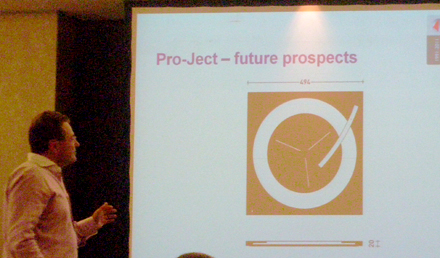
For the Pro-ject CEO, this is his Jobsian 'Oh, and one more thing…' moment – except his is a 'Let me show you something…' – as he reveals on the screen concepts for a next generation turntable and other products from the company.
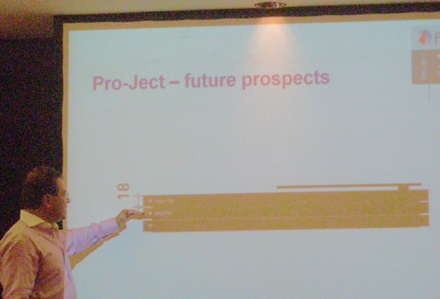
Yes, that's a turntable, standing just 2-3cm tall, with the platter sunk into the chassis – as he freely admits Bang & Olufsen has done in the past –, but with the addition of more stackable modules containing a phono stage, and amplifier and so on.
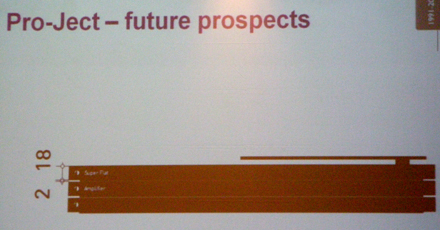
The system will have connectors built-in, hooking up without cables as units are stacked – again, it's been done before, but this time there's a simple determination behind the products: 'Keep it high-end, lose the cables, and keep the ease of use.'
It's not so much necessity as the mother of invention, as ingenuity as the mother of re-invention – it's done Pro-ject well for the past two decades, and will do in the future.
From what I've seen this weekend, it looks pretty certain the company, once only known for its budget turntables, will just keep on reinventing itself to suit the needs of the market and the consumer, and its desire to keep bringing better sound to the masses.
And it'll do so without losing sight of its roots.
Andrew has written about audio and video products for the past 20+ years, and been a consumer journalist for more than 30 years, starting his career on camera magazines. Andrew has contributed to titles including What Hi-Fi?, Gramophone, Jazzwise and Hi-Fi Critic, Hi-Fi News & Record Review and Hi-Fi Choice. I’ve also written for a number of non-specialist and overseas magazines.
